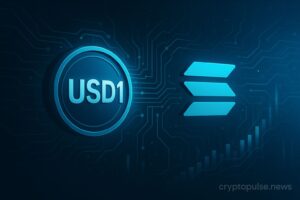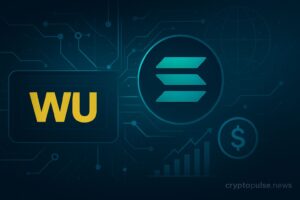OpenSea Confirms SEA Token Launch in Q1 2026
Half of the token supply will be allocated to the community as the NFT giant completes its transformation into a multi-chain trading hub.
OpenSea — one of the largest NFT and digital asset marketplaces — is preparing to launch its long-awaited SEA token in the first quarter of 2026. The move marks a pivotal moment for the platform as it evolves from a digital art marketplace into a multi-chain trading aggregator.
A Community-Centered Token Launch
OpenSea CEO Devin Finzer announced the launch in a recent post on X, revealing that 50% of SEA’s total supply will be allocated to the community. Early users and participants in OpenSea’s reward programs will receive separate allocations, positioning the token at the center of the platform’s next growth phase.
The SEA token will be fully integrated into OpenSea’s ecosystem with two core mechanisms:
- Staking: Users will be able to stake SEA behind their favorite collections or projects, effectively signaling support and participating in the platform’s incentive structure.
- Buybacks: OpenSea plans to direct 50% of its platform revenue toward buying back SEA tokens, a strategy designed to reinforce token utility and long-term value.
This dual approach aims to create sustainable demand while rewarding early supporters and active traders.
“You can’t fight the macro trend,” said Devin Finzer. “People want to trade everything—not just digital art.”
From NFT Leader to Multi-Chain Trading Powerhouse
The token launch comes amid OpenSea’s major strategic pivot. Once the dominant player in the NFT market, the platform has transformed into a multi-chain aggregator supporting 22 blockchains.
In October 2025, OpenSea recorded $2.6 billion in trading volume, with more than 90% driven by token trading rather than NFTs. This shift reflects broader market dynamics as interest in NFTs has cooled since the 2021 peak, when volumes were nearly ten times higher.
Key Developments Driving the Pivot
- Launch of a redesigned mobile app for seamless trading of multiple asset types.
- Introduction of perpetual futures trading, expanding beyond digital collectibles.
- Acquisition of Web3 platform Rally, aimed at accelerating mobile-first trading experiences.
- Integration with decentralized exchanges like Uniswap and Meteora, aggregating buy and sell orders and generating roughly $16 million in revenue over the same period through transaction fees.
OpenSea’s repositioning has helped the platform reclaim market momentum, with October shaping up to be its strongest month in more than three years.
Token Launch Delay Ends Speculation
The SEA token’s debut has been delayed for over a year, fueling speculation on prediction platforms such as Polymarket. Prior to Finzer’s announcement, traders had assigned nearly a 40% probability to a 2025 launch. After the official update, those odds dropped to under 1%.
The delay also reflected OpenSea’s shifting priorities during a volatile period for the NFT industry. By focusing on infrastructure, product upgrades, and market expansion before launching its token, the company is betting on long-term sustainability over hype.
From Boom to Bust — and a Reset
At the height of the NFT craze in January 2022, OpenSea was valued at $13.3 billion and generated $125 million in monthly revenue. But as the market cooled, its revenue collapsed to $3 million per month by late 2023. The downturn forced the company to cut its workforce by more than half, shrinking from around 175 employees to roughly 60 today.
Competition from Blur — a rival marketplace that offered zero fees and no creator royalties — intensified the pressure. OpenSea’s own decision to ease its royalty structure backfired, triggering backlash from artists and collectors who felt abandoned.
The platform responded with a comprehensive operational reset, relocating its headquarters to Miami and adopting a more agile, remote-first model.
A Surge in Trading Activity
Despite its earlier struggles, OpenSea has regained momentum in 2025. In just the first two weeks of October, the platform processed $1.6 billion in crypto trades and $230 million in NFT transactions, its highest trading activity since 2022.
The platform’s new structure — emphasizing asset diversity and liquidity aggregation — is already paying off. The upcoming SEA token is expected to further cement OpenSea’s role in the broader on-chain trading economy.
Looking Ahead: SEA as the Keystone of OpenSea’s Future
The SEA token launch represents more than a long-awaited airdrop — it’s a strategic cornerstone in OpenSea’s next phase. By tying platform revenue to token buybacks and enabling staking, the company aims to align community incentives with platform growth.
As OpenSea moves deeper into multi-chain liquidity aggregation, its shift reflects a larger industry trend: the convergence of NFTs, tokens, and DeFi into a single trading layer.
Whether SEA can recapture the energy of OpenSea’s early NFT era remains to be seen — but with a clear strategy and renewed market momentum, the company is betting big on its future as a cross-chain trading powerhouse.
Explore next:
➤ How To Get Crypto for Free
➤ Top 7 Crypto Wallets in 2025 for Beginners
➤ How to Store Cryptocurrency Securely
➤ How to Analyze Crypto Projects Before Investing
➤ What Is Ethereum and Why It Matters in Digital Finance








